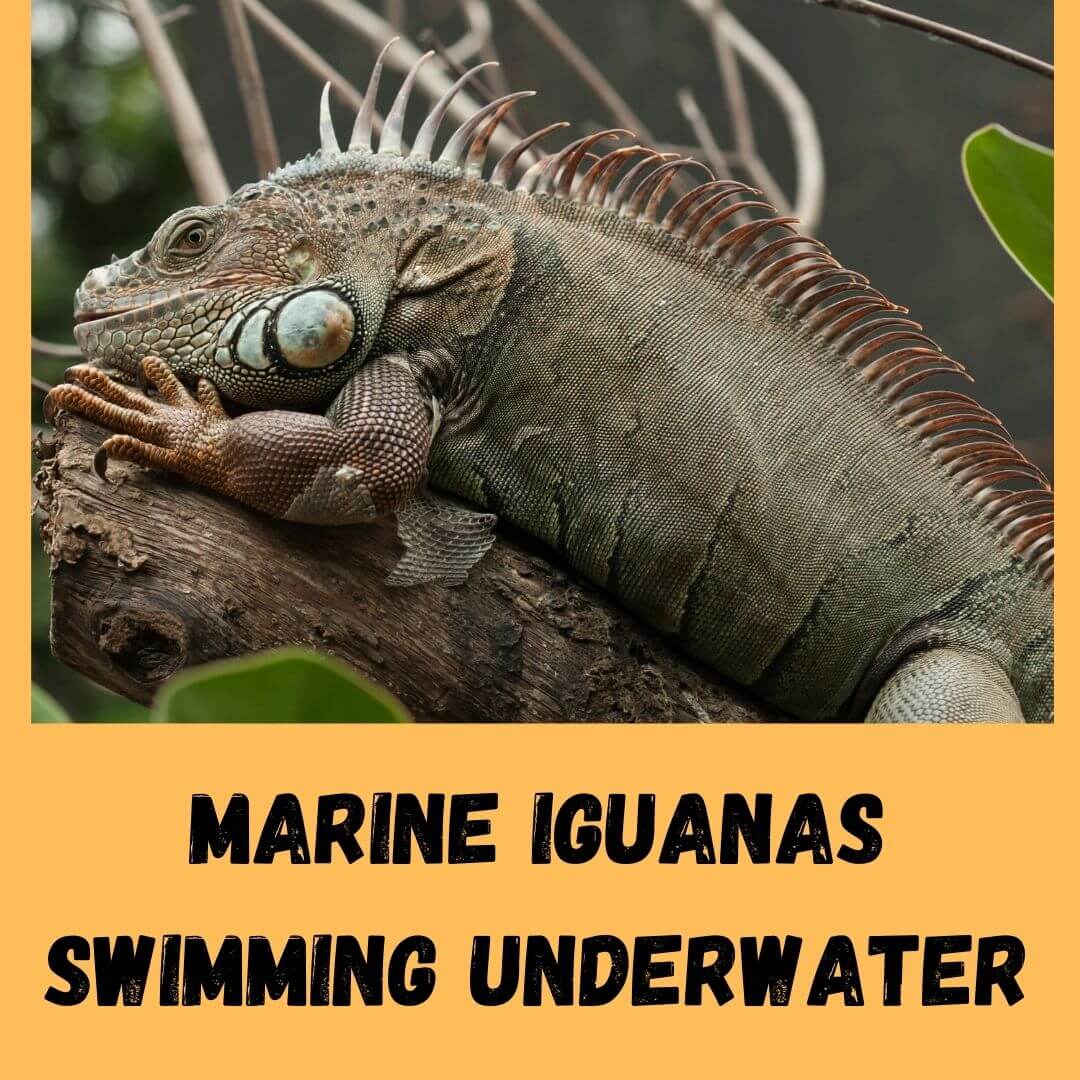Marine Iguanas are popular for their swimming ability and are also known for swimming in a snake-like motion. They tend to hold themself against the bottom of the ocean using their long claws for grazing in the water. As they’re primarily herbivorous, they dive into shallow Marine waters to eat algae that grow along with Rocky shows and underwater.
They are predominantly terrestrial. You can sight Marine iguanas sunbathing and resting along the shore of the river or ocean. This article will learn how long can a Marine Iguana can stay underwater.
How Long Can A Marine Iguana Stay Underwater?

As Marine iguanas can’t breathe underwater, they can easily stay 10-20 minutes without taking a breath. They are known to hold their breath for a long time and can even survive underwater for as long as 30-40 minutes.
They are one of the most adept iguana species because they can dive up to 98 feet. Marine iguanas are great swimmers and use their tails instead of legs or arm for swimming underwater. This motion works similarly to a crocodile and alligator.
Like crocodiles, they also tuck their legs against the body to become more streamlined and help the tail power the forward momentum and steer. However, Marine Iguanas are not fast swimmers like crocodilian species but can easily outrun them on land.
They can easily swim about 1.5 feet per second, which is the same as the human’s average swimming speed and ability. They cannot maintain their speed for a long time because they can’t breathe. Like a crocodile, Marine Iguanas prey with a quick shot through the water.
Hence, they come in a burst. Just because they spend a lot of time foraging algae underwater, they often ingest a large amount of saltwater. Therefore, Marine Iguanas sneeze out the SaltSalt using their efficient salt gland. If they don’t expel the SaltSalt from their body, they will become hydrated. They are very much dependent on their specialized gland, also known as the salt gland, to remove the SaltSalt from their body and blood.
Do you know that Marin iguanas can also shrink if fewer food sources are available? During El Nino climate events, food becomes scarce for them. To survive those days, Marine Iguanas shrink by 20% until their preferred algae return to a high level.
As soon as the climate sets in and algae grow to a high level, Marine Iguanas quickly regain the lost size. Since Marine Iguanas are from such a tiny geographic area, they’re vulnerable to extinction also. Therefore, they are protected on the Galapagos island by IUCN and many other authorities.
Do you know that people brought many pets and animal species to the island in the past, like cats, dogs, and even germs that attacked Marine Iguana’s eggs and juveniles? Now, it is very tough to eradicate those invasive species brought by humans. And now, this is likely to continue to threaten this beautiful Marine Iguana’s population. Let’s look at a few hard facts about Marine Iguanas and learn what is unique about them.
9 hard facts about marine Iguana
- Marine Iguanas have blunt snouts that allow them to eat algae grown underwater.
- Marine Iguanas come with flattened tales that help them steer and move forward to swim efficiently.
- Marine Iguanas are the only lizard that can dive more than 65 feet underwater or in the ocean.
- Marine Iguanas can grow up to 4.3 ft long, whereas females can be about 2 ft long.
- Marine Iguanas are known to spend only a few minutes underwater when they need to forage for food.
- Marine Iguanas are the only Marine lizard species you can ever find globally.
- Marine Iguanas are endemic to Galapagos Island.
- Marine Iguanas have been believed to evolve around 4.5 millions year ago from the land Iguana brought to the Galapagos island, which adapted to a sea fairy life for survival.
- Marine Iguanas are the only species of Iguana that sneeze out excess SaltSalt from their body which they collect underwater through a nasal gland.
What is unique about marine iguanas?
Many facts make a Marine Iguanas unique when compared to other species. The first thing is its ability to change color during the mating season. Like its subspecies, Marine Iguanas also prefer adopting different colors in the mating season.
During the mating season, you will find Marine Iguanas being the most colorful. The often turn their color into bright red or bright green. Other than this, out of all some species, Marine Iguanas is the one that enjoys diving and swimming to an extreme level.
Incapacity can be problematic as they require lots of bath time. Other than this, Marine Iguanas are the only sea-going lizard globally, and their true ability to swim is still undiscovered. We’re still unaware of how far they can swim.
Marine Iguanas have been seen swimming and relocating themselves between Islands. Sometimes, Marine Iguanas have been seen relocating themselves between Islands with a distance of up to 65 km between them. As Marine Iguanas are used to being in the water, it is best never to adopt one if you can’t provide enough baths.
At first, they may be stressed out during the first bath, but with time and experience, they will get comfortable. It is important to offer 20-30 minutes of the bathing session to your Marine Iguanas as it helps in providing enrichment, hydration, and shedding.
The water is known to soften and moisten the shed skin of reptiles, which helps it come off efficiently and smoothly. When bathing Marine Iguanas, choosing warm water for their well-being is important. Since Marine Iguanas are cold-blooded reptiles, it is best to offer warm water rather than cold water, which could be a culprit of a significant body temperature drop.
The water should be warm to the touch but not too hot or steaming. Avoid testing the water using your finger. Just like we check the water of our baby bath, you should also use your elbow. Let’s talk about how Marine Iguanas regulate their body temperature underwater.
How Do Marine Iguanas Regulate Their Body Temperature Underwater?

Marine Iguanas cannot regulate body temperature without an external source of heat. Therefore, when diving in the water and staying underwater to forage for food, they typically use the heat they had conserved during nighttime.
In the morning, Marine Iguanas also absorb heat by basking in the sunlight until they conserve enough heat to dive into the sea. Adding to this, Marine Iguanas’ heartbeats also slow to half, which helps them conserve more energy and use their conserved heat for as long as possible underwater.
Interesting Further Reading
- Can Iguanas Eat Nectarines? 5 Steps To Serve
- How To Keep Iguana Cage Humid? [5 Easy Ways]
- How Long Does It Take For Iguana Eggs To Hatch?
Are Marine Iguanas Endangered?
Yes. Marine Iguanas are vulnerable and endangered, according to the IUCN red list. Marine Iguanas were last assessed in the year 2019. The main culprit for such a decline in their population is the invasive species humans brought to the islands.
Invasive species like dogs and cats had a devastating impact on the population. Since they were alone initially on the island, Marine Iguanas were poorly adapted to defending themselves against large land predators.
Thus invasive species like dogs and cats had a devastating impact on their population by predating Marine Iguana’s eggs and juveniles. Climate changes like the El Nino event also affect the Marine Iguana population as food sources and supplies become scarce.
FAQ
Conclusion
You have all the ideas of Marine Iguana‘s swimming ability underwater. Many iguanas species enjoy swimming and diving in their natural habitat. Still, these species are the only ones to survive underwater for such a long period.
Even though they cannot breed underwater like a fish, they can hold their breath for as long as 30-40 minutes. Marine Iguanas not only dive underwater to forage for food but also enjoy a relaxing float or to escape predators.
I have tried my best to give you all the information about Marine Iguanas and their ability to hold their breath underwater. Suppose you like our articles and consider sharing them. Many people learn about these vulnerable Iguana species that need to be protected and should be avoided as pets.

94% of pet owners say their animal pal makes them smile more than once a day. In 2007, I realized that I was made for saving Animals. My father is a Vet, and I think every pet deserves one. I started this blog, “InPetCare”, in 2019 with my father to enlighten a wider audience.

